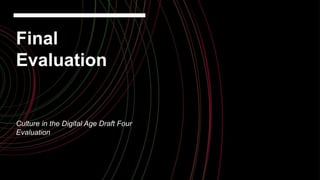The document summarizes the student's work on creating a documentary about "Culture in the Digital Age" for a class project. It describes the various stages of production, including research, pre-production paperwork, conducting and recording interviews, filming a band, and the post-production and editing process. It details some technical issues encountered along the way with equipment and sound quality. Overall, the student learned new skills in video and sound editing, successfully completed the documentary on time, and feels it achieved the goals of being informative and appealing to the target audience.









